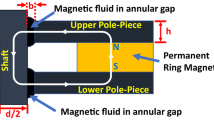Abstract
To improve the pressure capability of magnetic fluid seal with more than a 0.25 mm single edge gap, a magnetic fluid sealing structure with multiple magnetic sources which has five permanent magnets was designed. Magnetic field distributions under the pole pieces of the magnetic fluid seal with single and multiple magnetic sources were simulated by finite element method and its sealing pressure difference could be calculated according to the theoretical formula of the magnetic fluid seal. The effects of sealing gap height and magnetic source amount on the sealing capability were investigated experimentally. The theoretical and experimental results were compared, analyzed and discussed. The results demonstrated that the magnetic fluid seal with multiple magnetic sources was an effective method to improve the sealing capability for the rotary shaft with large gaps. The theoretical results agreed well with the experimental results when the height of the single edge gap was equal to 0.4 mm. However, it was found that when the height of the single edge gap was larger than 0.4 mm, the difference between the theoretical values and experimental values increased with the gap height because part of magnetic source had less or even no effect on magnetic fluid sealing capability.
Similar content being viewed by others
References
Li D C. The Theory and Application of Magnetic Fluid (in Chinese). Beijing: Science Press, 2003
Cong M, Shi H L. A study of magnetic fluid rotary seals for wafer handling robot. Int J Intell Syst Technol Appl, 2010, 8(1): 158–170
Sarma M S, Stahl P, Ward A. Magnetic-field analysis of ferrofluidic seals for optimum design. J Appl Phys, 1984, 55(6): 2595–2597
Zou J B, Li X, Lu Y, et al. Numerical analysis on the action of centrifuge force in magnetic fluid rotating shaft seals. JMMM, 2002, 252: 321–323
Li Q, Xuan Y M, Li B. Simulation and control scheme of micro-structure in magnetic fluids. Sci China Ser E-Tech Sci, 2007, 50(3): 371–379
Choi H S, Kim Y S, Kim K T, et al. Simulation of hydrostatical equilibrium of ferrofluid subject to magneto-static field. IEEE Trans Magn, 2008, 44(6): 818–821
Babic S, Akyel C, Gavrilovic M M. Calculation improvement of 3D linear magnetostatic field based on fictitious magnetic surface charge. IEEE Trans Magn, 2000, 36(5): 3125–3127
Ravaud R, Lemarquand G, Lemarquand V, et al. Analytical calculation of the magnetic field created by permanent-magnet rings. IEEE Trans Magn, 2008, 44(8): 1982–1989
Furlani E P. Permanent Magnet and Electromechanical Devices. New York: Academic Press, 2001
Selvaggi J P, Salon S, Kwon O M, et al. Computation of the three-dimensional magnetic field from solid permanent-magnet bipolar cylinders by employing toroidal harmonics. IEEE Trans Magn, 2007, 43(10): 3833–3839
Ravaud R, Lemarquand G, Lemarquandet V, et al. Discussion about the analytical calculation of the magnetic field created by permanent magnets. PIER B, 2009, 11: 281–297
Liu T, Cheng Y, Yang Z. Design optimization of seal structure for sealing liquid by magnetic fluids. JMMM, 2005, 289: 411–414
Shen H, Hui X Q, Wang W. Electron microscopy observations of surface morphologies and particle arrangement behaviors of magnetic fluids. Sci China Ser E-Tech Sci, 2003, 46(2): 168–172
Cong M, Wen H Y, Du Y, et al. Coaxial twin-shaft magnetic fluid seals applied in vacuum wafer-handling robot. Chin J Mech Eng, 2012, 25(4): 706–714
Krakov M S, Nikiforov I V. Influence of the meridional flow and thermomagnetic convection on characteristics of magnetic fluid seal. Techn Phys, 2011, 56(12): 1745–1753
Mitamura Y, Takahashi S, Amari S, et al. A magnetic fluid seal for rotary blood pumps: Effects of seal structure on long-term performance in liquid. J Artif Org, 2011, 14(1): 23–30
Polevikov V, Tobiska L. Influence of diffusion of magnetic particles on stability of a static magnetic fluid seal under the action of external pressure drop. Comm Nonlinear Sci Numer Simul, 2011, 16(10): 4021–4027
Matuszewski L. Multi-stage magnetic-fluid seals for operating in water-life test procedure, test stand and research results. Polish Marit Res, 2012, 19(4): 62–70
Matuszewski L, Szydlo Z. Life tests of a rotary single-stage magnetic-fluid seal for shipbuilding applications. Polish Marit Res, 2011, 18: 51–59
Rosensweig R E. Ferrohydrodynamics. New York: Dover. Publications, INC, 2002. 307–323
Author information
Authors and Affiliations
Corresponding author
Rights and permissions
About this article
Cite this article
Yang, X., Zhang, Z. & Li, D. Numerical and experimental study of magnetic fluid seal with large sealing gap and multiple magnetic sources. Sci. China Technol. Sci. 56, 2865–2869 (2013). https://doi.org/10.1007/s11431-013-5365-4
Received:
Accepted:
Published:
Issue Date:
DOI: https://doi.org/10.1007/s11431-013-5365-4




